Your cart is currently empty!
What Does a Potter Do? A Day in the Life of a Potter
Published:
Last Updated:
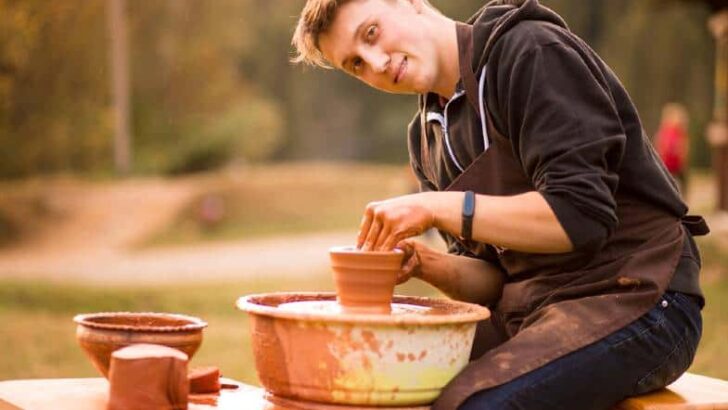
Affiliate Disclaimer
As an affiliate, we may earn a commission from qualifying purchases. We get commissions for purchases made through links on this website from Amazon and other third parties.
If you like making things out of clay, you may have thought about honing your skill and becoming a potter. But what does a potter do? And what is their working life like day-to-day? Here is all you need to know about the work and life of a potter. And what you can expect if you choose to tread this creative path….
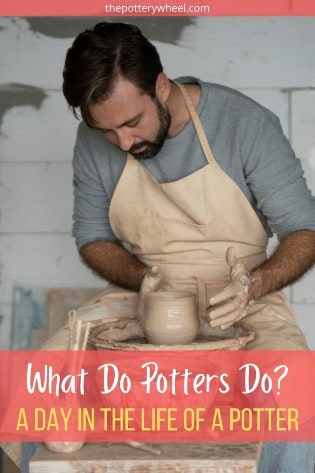
What is a Potter?
A potter is a craftsperson or artist who makes objects out of clay.
Usually, making pottery is described as a craft. This is partly because the objects that potters made are often functional. For example, mugs, plates, bowls, and vases. This is different from ‘fine art’ which is valued because of its visual appeal rather than how it can be used.
However, these days potters often refer to themselves as ‘makers’. One of the reasons for this is to avoid having to pigeonhole themselves either as a craftsperson or an artist. Lots of potters think of themselves as creating crafted and artistic objects. The word ‘maker’ is one way to avoid the distinction.
Also, the difference between functional pottery and visual art is not completely accurate.
Not all pottery is functional. For example, some vessels are made in a way that means they are not water-tight. So, whilst they might look like a vase, they can’t be used to hold water. As such, they are more like fine art than craft. Equally, some art is designed to be functional, so, the distinction is not 100% clear-cut (source).
For the most part, potters have their own studio and work for themselves. They are self-employed, and their business is the production of pottery, generating an income from selling the pottery they make.
Sometimes potters are hired by a pottery or design studio to work on the mass production of pottery ware. However, jobs working at a pottery are rare, and most of the time potters work for themselves.
What Does a Potter Do?
Making pottery takes time and patience. A piece of pottery starts as a lump of clay and is fashioned into the finished piece. There are various stages to making a piece of pottery.
The first stage is preparing the clay, which involves a process called ‘wedging’. Wedging clay is a little like kneading bread dough. It involves working the clay with your hands to get rid of air bubbles in the clay. Wedging also gives the clay a nice, even workable consistency.
The clay is then shaped into the desired piece of pottery. There are different techniques used to shape the clay, which I will say a little about later.
Once the piece of potter has been shaped, time is spent tidying up and finessing the piece. The clay is then left to dry out.
The dried clay is often called ‘greenware’. Greenware pottery is sometimes lightly sanded to get rid of lumps and bumps. Or it might be decorated with a particular kind of ceramic paint called ‘underglaze’.
Once the final touches are made, the clay is baked in a ceramic oven called a kiln. This process is called firing. Pottery is normally fired twice. The first firing is called the bisque fire. And the temperature of the kiln reaches around 1000c.
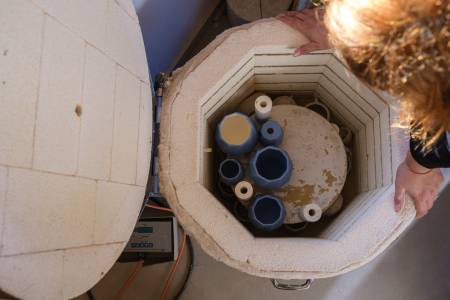
After the bisque fire, the pottery is coated with ceramic glaze. This is a little like a layer of paint. Glaze can be applied by brushing, dipping, or airbrushing.
Once the glaze is applied, the pots are fired a second time. This is called a glaze fire. And the temperature of the kiln will be 1832-2372F (1000C and 1300C).
When the pots have been glazed, the kiln cools and is then unloaded.
The potter then has the task of selling their ware.
Things a Potter Makes
Potters make a whole range of objects out of clay. These include, amongst other things, cups, mugs, plates, platters, bowls, dishes, teapots, and vases.
However, pottery is not restricted to obvious functional items. Most things can be made out of clay and potters will experiment. Other examples of what a potter might make are toast racks, lemon squeezers, egg cups, and bookends.
In addition to this, some potters will focus on making clay items that are more ornamental. For example, mirror and picture frames, wall plates, and clock designs.
So, the options of what to make are many and varied as a potter.
There are also different ways of making pottery. The most common ways to make pottery include the potter’s wheel, hand-making, and a process called ‘slip casting’.
Let’s look briefly at each of these:
The Pottery Wheel
A pottery wheel is a mechanical device with a metal plinth (or wheel head) that rotates on an axis.
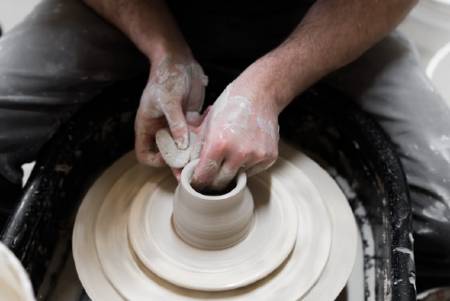
Most pottery wheels today are driven by electricity. But in the past, pottery wheels were operated by a foot lever. This kind of wheel was called a kick wheel.
The clay is pressed onto the wheel head. As the wheel head rotates, the potter uses their hands to shape the clay into the desired form. This is called ‘wheel throwing’.
Hand Building
Pottery does not have to be made on a potter’s wheel. Some potters prefer to hand-build their pottery, which as its name suggests involves fashioning the clay by hand. The main methods of hand-building clay involved pinching the clay or making pots out of coils or slabs of clay.
Slip Casting
Slip cast pottery is made by pouring liquid clay into a plaster mold. The liquid clay is simply clay dissolved in water. When the water evaporates, a solid clay item remains in the mold. When the mold is removed the clay object can be tidied up and fired.
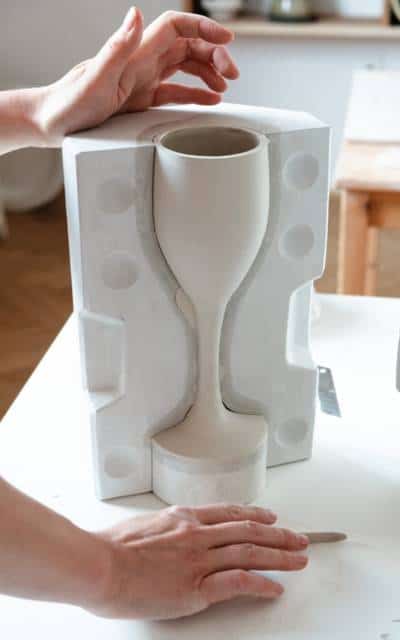
What is a Potter’s Day Like?
So, what does a potter do day-to-day? A large part of a potter’s day involves running their pottery studio. This could be a hired space in an art studio, or on business premises.
Or if you are lucky enough to have space at home, a pottery studio can be set up in a home setting. A storage shed or garage can be converted to make a great pottery studio space.
Part of the day will be spent making the pottery out of clay. This can involve all or any of the techniques outlined above, that is, wheel throwing, hand-building, or slip casting.
Drying pottery out needs to be a gradual process. If clay dries too quickly, it can crack. So, at any given time, a potter will have pots at various stages of drying in the studio.
Firing pottery in a kiln takes time. There are many different types of kiln. The most common type of studio kiln is an electric kiln, though some potters prefer to use gas-fired kilns.
Kilns come in different shapes and sizes, and the type of kiln will determine how long it takes to fire pottery. Nevertheless, as a rule of thumb, it takes around 8-10 hours to bisque fire pottery.
And a glaze fire in an electric kiln can take another 10-12 hours. So, firing pottery takes a lot of time.
Plus, you have to factor in the time it takes for the kiln to cool down before it can be unloaded. A tightly packed kiln, full of pottery can take as long to cool down as it did to fire the pots.
Experimenting
As well as making pottery to be sold, a potter will spend time honing their craft. This can involve the following:
- Learning new techniques and innovating with styles
- Making glazes
- Experimenting with new types of clay
Making pottery is a creative process. It’s important for the pottery to find time during the day to develop their style and keep their making process fresh.
Any Other Business?
Some of the other aspects of running a pottery studio involve the following:
Cleaning the studio
Making pottery is messy. Dust created by clay and glaze contains silica. Silica is a known carcinogen, so it’s very important that a pottery space is kept clean. It is best to minimize any clay or glaze dust in your working environment to protect your health.
Paperwork
Running your own business involves keeping on top of accounts, receipts, and taxes. Other considerations involve insuring your studio and pottery equipment.
Promoting and Selling Your Work
In order to sell your pottery, people need to know that it is available to buy. Some of the ways that potters use to promote their pottery are:
- Social media
- Using a sellers platform such as Etsy
- Having local exhibitions of their work
- Joining a local pottery and ceramics organization and networking with other potters
- Opening their own shop front or gallery
Last but not least, time needs to be spent packaging up and posting the pottery you have sold. A lot of sales will be to people who are not local to you. A potter needs to make sure that buyers get their pottery in one piece.
It’s probably an obvious thing to say, but pottery can break if it is not handled with care. Most of us are painfully aware of how roughly items in the post or sent by courier can be handled. So, potters do need to spend time, care, and money ensuring that their produce is well packaged.
What Potters Need to be Successful
You don’t need any particular formal qualifications to become a potter.
Some potters attend art school and specialize in ceramics. After completing a bachelor of the arts degree, they may go on to specialize further by completing a master’s degree.
Sometimes potters might go on to work as an artist in residence at a training institution. This gives them time to develop their skills further and establish a name for themselves.
However, a lot of potters are self-taught. If you have not attended art school, most local community colleges and art schools will run pottery classes. You can pick up a lot of skills by reading pottery books, watching YouTube videos, and simply practicing.
However, nothing quite beats attending a pottery class in person. If you find a pottery tutor, you will get one-to-one feedback on how to develop your skills. This will speed up the learning process, and improve your technique.
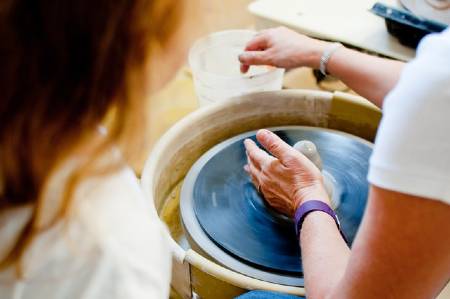
If you are lucky, there might be an organization near to you that offers an apprenticeship as a potter. This is an excellent way to develop your skills as a potter. You would learn the day-to-day nitty-gritty of running a pottery studio. And you would be able to learn from an accomplished and established potter.
Personal Qualities:
Some of the personal qualities and skills that stand you in good stead as a potter are:
- Some creative flair.
- Practical know-how and a curiosity about how things are made.
- An enjoyment in making things with your hands.
- Resilience – an ability to cope with disappointment when your projects don’t work out and a willingness to try again.
- People skills – communicating well with prospective and existing customers and building rapport.
- Courage – being willing to put your work out there for others to like or dislike. Remember not everyone will like what you make, but some people will love it!
Why Become a Potter?
A key reason to become a potter is if you enjoy making beautiful, functional objects with your hands. Making pottery can give you tremendous creative satisfaction. The more you practice your craft, the more accomplished your pottery work will become.
By making pottery, you are making sustainable produce. Unlike a paper cup that is thrown away after one use, handmade pottery is generally cherished by the user.
Although making pottery does contribute to your carbon footprint, you will be making objects that will be enjoyed for years. Making pottery is a way of reversing the general trend towards instant and disposable produce.
Finally, in making pottery, you are producing objects that will give joy to your customers! A potter makes unique items that spread pleasure and happiness. Why not be a part of that!
Final Thoughts
I hope this has given you a clear answer to the question what does a potter do. A potter who is making a living out of ceramics is running their own business. So, as well as having creative flair, it helps to have some business sense too. If you can get that combination right, then working as a potter can be a very satisfying way of life.



